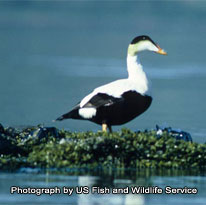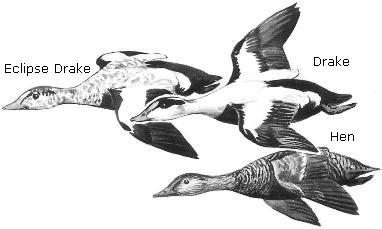Wildlife - Species

Species Specific Regulations
Common Eider
Licenses: Hunting License required. Migratory Bird Hunting and Conservation Stamp (Federal Duck Stamp) that is validated by the hunter signing the stamp in ink across the face of the stamp
Limits: Please see Migratory Bird Regulations for any game zones restrictions or Limitations.
Common Eider (Somateria mollissima )

Description
Common eiders are boldy colored black and white birds with a distinctive wedge-shaped head and long bill. These thick-necked stocky birds alternate flapping and sailing in flight.
Average Size
Common eiders have an average length of 23 1/2 inches and an average weight of 5 pounds.
Range
Common eiders occur in the United States mainly along the Alaskan and New England coasts and occasionally south to New Jersey. Common eiders are very rare visitors to South Carolina.
Preferred Habitat
During the breeding season these ducks can be found on coastal islands, islets, and narrow low lying points of land. During the nonbreeding season they can be found on shoal marine waters in outer coastal areas. Here they use offshore shoals and archipelagoes.
Food Habits
Eiders primarily consume benthic invertebrates like mollusks, crustaceans, and echinoderms.
Reproduction
Eiders arrive on the breeding grounds as breeding pairs and some may form long-term bonds. Eiders are colonial nesters that lay in a variety of habitats from arctic tundra heath to boreal forest. The female builds her nest on the ground, near water, and usually some cover. The female creates a depression in the ground in which she lays 1-14 olive eggs.
Sound
Hoarse, grating and cooing sounds described as kor-korr-korr.
Behavior
- Male and female protect a moving territory around pair during the breeding season.
- Form large flocks in the nonbreeding season often greater than 10 thousand birds.
Citations, Publications and Literature
U.S. Fish & Wildlife Service, Federal Duck Stamp Office Presents: North American Waterfowl (Adobe PDF file)
Goudie, R. Ian, Gregory J. Robertson and Austin Reed. 2000. Common Eider (Somateria mollissima), The Birds of North America Online (A. Poole, Ed.). Ithaca: Cornell Lab of Ornithology; Retrieved from the Birds of North America Online
South Carolina waterfowl hunters 16 and older are required by state law to obtain a state migratory waterfowl permit and Migratory Game Bird permit. Both permits must be in the hunter's possession while hunting or transporting legal waterfowl. A state waterfowl permit is included with the Lifetime Senior, Lifetime Gratis and Disability Licenses. S.C. residents who hold a Lifetime Senior or Lifetime Gratis License are not required to have a Migratory Game Bird permit.
National Migratory Bird Harvest Information Program (HIP)
The waterfowl permits and HIP permits are available from select DNR offices and from hunting and fishing license agents.
